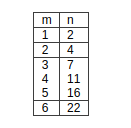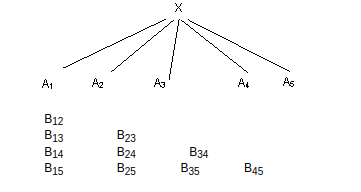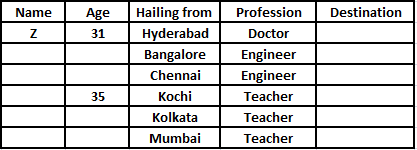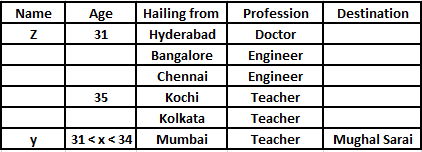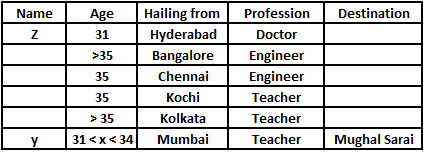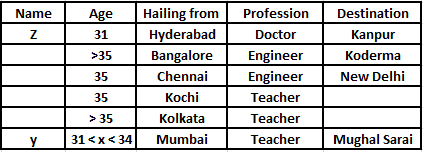XAT 2011 Question Paper - DM
For the following questions answer them individually
Indian government may hold top executives responsible if state - run power companies fail to meet performance targets and punish them with fines and transfers. The strict performance parameters are aimed at ensuring that at
least the reduced target for 62,000 MW of generation capacity addition is achieved before the end of the 11th Plan, said a power ministry official. Performance of chairman and managing directors of the power Public Sector Units (PSUs) in project implementation will be assessed as per the terms and conditions stipulated in
the company’s memorandum of understanding (MoU) with the power ministry, he said, requesting anonymity. Performance parameters of executives had came under strict scrutiny due to a lack of progress in capacity addition program. While the target for the 11th five year plan has already been scaled down by the government from 78,500 MW, in the first three years of the plan yielded only 22, 302 MW of fresh capacity.
If you were the chairman of one of these power PSU’s, which of the following statements (all of which are assumed to be true) could best be used in order to strengthen your case against the government holding top executives responsible?
i. The labour unions, owing allegiance to ruling party at the Center, are not allowing work to progress with their demands for wage hikes that are untenable.
ii. The actions of the mid - level management are not in line with the objectives laid down by the top management.
iii. The delays have been due to difficulties in obtaining funds at reasonable interest rates on account of the recessionary conditions.
iv. We are not to blame. The government is not doing enough to ensure availability of sufficient fuel to power the existing plants, let alone the new plants.
v. The government had ignored the infrastructure availability like roads etc., and environmental clearances required for such projects and therefore set an unrealistic target to begin with, and the revised target is also unrealistic as well.
The CEO of ABC Telecom Ltd. (ABC) is in a quandary since he received the telephone call in the morning from his counterpart at LMN Telecom Ltd. (LMN). Both companies were engaged in a bitter experience a couple of years ago when they had attempted to merge with the intention of creating a behemoth telecom company, possibly the largest in the world. The merger had fallen through due to opportunistic behavior on the part of Mr. Das, then CEO of LMN. During the time the merger talks were taking place, Mr. Das had also approached a few other suitors for LMN in an attempt to force ABC to pay a higher price. Further, there were reports of attempts by management of LMN to scuttle the deal. Back then, ABC had also faced stiff opposition to the deal from one of its large shareholders.
Since then, a lot has changed for both companies. The bleak economic conditions due to recession had led to a drastic fall in the market value of both companies, with ABC comparatively losing much more in terms of market value. Raising money has become more difficult for both companies, especially for LMN. On the brighter side for ABC, the opposing shareholder had recently sold off his stake to another investor who earlier had supported the original merger deal with LMN a couple of years ago.
Which of the following would be the most appropriate line (s) of thought for the CEO of ABC to adopt in response to the offer by LMN?
I. Once bitten twice shy. There is simply no way I can think of resuming talks with LMN after their unethical behaviour the previous time around. I would rather spend my time on merger discussions with other companies.
Ii. The deal may make less business sense this time around. However, if it goes through, I will become the CEO of the world’s largest telecom company. So let us try our luck once more.
Iii. I will resume talks only if they provide guarantees as to the reimbursement of our expenses incurred, in the event of the deal not materializing.
Iv. Let me not be biased against dealing with LMN, if we can secure the deal at a reasonably low price, benefiting our shareholders, let us go ahead with it.
V. I am not sure if we can raise the money now. In any event, they are the ones facing greater financial problems. So let’s not hurry now. We might have an opportunity to buy them out at a cheaper price later.
The merger of ABC and LMN has been confirmed after detailed negotiation with LMN holding the majority share of the resultant entity. LMN has financed the merger by taking debt at higher - than - market interest rates from its bankers, in the hope that it would be able to streamline operations and reduce costs in the resultant entity which will allow it to repay the loan. If you were an investor looking to invest in telecom companies, which of the following could be the strongest reasons for staying away from investing in resultant entity?
For the following questions answer them individually
Wind turbine maker Leone Energy posted a net loss of Rs. 250 crore for the fourth quarter ended March 31, 2010 as against a net profit of Rs.350 crore in the same quarter a year - ago. In the financial year 2009 - 10, the company clocked a gross income of Rs.6,517 crore, as against Rs.9,778 crore in the previous year. Leone Energy clocked a loss of Rs.1,100 crore in 2009 - 10, as against a net profit of Rs.320 crore in 2008 - 09. The sales revenues stood at Rs.22,400 crore fo the year, approximately 21 per cent less against Rs. 28,350 crore last year. For the financial year ending March 31, 2010, Leone Energy’s sales volume (in terms of capacity of projects executed) was 4,560 MW from 2,935 MW a year ago. The CEO of Leone Energy in his message to shareholders suggested that the poor performance of the company was the result of adverse economic conditions during the year ended March 31, 2010 . You are a shareholder owning 5% of the shares of Leone Energy, have seen the stock price decline by more than 50% during the year 2009 - 10, and are quite upset with the way the management has been handling the business. You have decided to confront the management at the next shareholders’ meeting and have chosen the following 5 point to argue against the CEO’s version of the story. In light of the above paragraph, select the most appropriate order of these 5 statements that you, as a disappointed shareholder, should adopt as a stringing and robust preface in your case against the management in front of the management and other shareholders.
a. The management is not doing its best to maintain the profitability of the company.
b. The company has actually increased its sales volume during the year under consideration.
c. The adverse economic conditions have led to a worldwide increase in the adoption of alternative energy sources, reflecting in all - time highest profits for wind turbine makers in both developed and developing countries.
d. The management has been lax with its employees as the management enjoys a large set of benefits from the company that they would have to forgo if they became strict with employees.
e. The company is trying to increase sales by charging lower, unprofitable prices.
On 1st March, Timon arrived in a new city and was looking for a place to stay. He met a landlady who offered to rent her apartment at a reasonable price but wanted him to pay the rent on a daily basis. Timon had a silver bar of 31 inches, and an inch of the silver bar was exactly equal to a day’s rent. He agreed to pay an inch of the silver bar towards the daily rent. Timon wanted to make minimum number of pieces of the silver bar but did not want to pay any advance rent. How many pieces did he make?
Read the following case and choose the best alternative.
Chetan Textile Mills (CTM) has initiated various employee welfare schemes for its employees since the day the mill began its operations. Due to its various welfare initiatives and socially responsible business practices, the organisation has developed an impeccable reputation. Majority of the regular workers in Chetan Mills had membership of Chetan Mills Mazdoor Sangh (CMMS), a non political trade union. CMMS had the welfare of its member as its guiding principle. Both CTM and CMMS addressed various worker related issues on a proactive basis. As a result no industrial dispute had been reported from the organiza tion in the recent past.
These days majority of the employers deploy large number of contract labourers in their production processes. In an open economy survival of an organization depends on its competitiveness. In order to become competitive, an organization must be able to reduce cost and have flexibility in employment of resources. Engaging workers through contractors (contract labourer) reduces the overall labour cost by almost 50%. Indian labour legislations make reduction of regular workers almost impossible, but organisations can overcome this limitation by employing contract labourers. Contract labourers neither get the same benefit as regular employees nor do they have any job security. According to various recent surveys, government owned public sector units and other departments are the biggest employers of contract labourers in the country. Contractors, as middle - men, often exploit the contract labourers, and these government organizations have failed to stop the exploitation.
Over time CTM started engaging a large number of contract labourers. At present, more than 35% of CM’s workers (total 5,000 in number) are contract labourers. CMMS leadership was wary about the slow erosion of its support base as regular workers slowly got replaced by contract workers and feared the day when regular workers would become a minority in the mill. So far, CMMS has refused to take contract labourers as members.
Recently, based on rumours, CTM management started to investigate the alleged exploitation of contract labourers by certain contractors. Some contractors felt that such investigations may expose them and reduce their profit margin. They instigated contract labourers to demand for better wages. Some of the contract labourers engaged in material handling and cleaning work started provoking CTM management by adopting violent tactics.
Today’s news - paper reports that police and CTM security guards fired two or three rounds in air to quell the mob. The trouble started while a security guard allegedly slapped one of the contract labourers following a heated argument. Angry labourers set fire to several vehicles parked inside the premises, and to the police jeeps.
In the wake of recent happenings, what decision is expected from CTM management? From the combinations given below, choose the best sequence of action.
I. Stop the current investigation against the contractors to ensure industrial peace; after all allegations were based on rumours.
II. Continue investigation to expo se exploitation and take strong actions against trouble makers.
III. Get in direct touch with all contract labourers through all possible means, communicate the need for current investigation to stop their exploitation, and convince them regarding CTM’s situation due to competition. Also expose those contractors who are creating problems.
IV. Promise strong action against the security guards who are guilty.
V. Increase the wages of contract labourers.
In the current context, which among the following represent the most suitable reaction from CMMS leadership?
Out of the options given below, which one would be the best policy decision by government at the national level?
The criminals in the surrounding area often took their cue from the situation in the mill, creating law and order problems outside the mill which would later make it difficult for workers to come to mill safely. Given the circumstances, identify the stakeholder that should be the immediate priority of CTM management.
Answer question based on the following information.
Alex Company has its office at the third floor of a multi - storied building in Mumbai. There are 5 rooms to be allotted to 5 managers (designated M1 to M5), each of whom will occupy one room. Each room has its own advantages and disadvantages. Some have the sea view, while others are closer to either the lift or the dining room, while some are more spacious. Each of the five managers was asked to rank the room preferences amongst the rooms 301, 302, 303, 304 and 305. Their preferences were recorded as follows:
Table:

Some managers did not indicate any preference for some rooms, as they did want to be there under any condition. The company decided to allot rooms to managers in such a way that the managers get rooms as per their best preference or close to that.
If manager X gets his/her 1st choice, then his/her preference ranking is 1 and so on. Management decided to allot rooms so that the sum of the preference ranking of all the managers is minimized. What is the total preference ranking for the rooms allotted to all the managers?
Suppose that Manager M2 decides not to join the new zonal office and Manager M6 takes his place. Manager M6 has the following preference ranking in decreasing order: 301, 302, 303, 304 - in this case what would be the sum of the preference ranking allotted to all five managers?
Answer question based on the following information
Every Saturday, the members of Raja Harish Chandra Club meet in the evening. All the member of the club are honest and never lie. Last Saturday, the following conversation was heard at one of the table with five members sitting around it.
Satya Sadhan: In this club not all members are friends with each other.
Satyabrata: None of the pair of friends in this club has any common friend.
Satyajit: Every pair of member who are not friends has exactly two common friends in this club.
Satya Pramod: There are fewer than 22 people in this club.
Answer the question based on the following information:
In the country of Gagan, air travellers can buy their tickets either directly from the airlines or from three websites that are licensed to offer ticketing services online. In Gagan, most of the commercial transactions are done electronically, and all citizens have an account with its national bank, CeeCee. As a result, the three websites have become popular, and each transaction through these websites carries a surcharge of Gs. 250 (Gs. refers to Guppes, the currency of Gagan). Given below are four post new - year (January 2, 2011, to February 28, 2011) offers from three competing websites:
Cozy _ travel Offer: Make a confirmed booking for any service (flight ticket, hotel or rail tickets) through Cozy_travel.com from December 5, 2010 to February 8, 2011 and become eligible for two free air tickets (offer is limited to the base fare). Free tickets have to be booked through online request from January 1, 2011 to February 28, 2011. The request for free tickets should be submitted at least twenty-one days in advance. Free tickets are non-amendable (except the passenger's name) and cannot be cancelled. Free ticket cannot be exchanged for cash or kind with anybody. Cozy_travel will try its best to secure the free ticket as per the request. However, ticket confirmation is subject to airline schedule and set availability in airlines selected and finalized by Cozy_travel from specific available airlines.
Cool_yatra Offer: Book any air ticket of any airline on Cool_yatra.com on or after December 21, 2010 and get your next ticket free. Under this offer, only the base fare of the free ticket will be refunded by Cool_Yatra.com. The customer will have to bear the rest of the charges (other fees and surcharges). The value of the base fare will be refunded to the passenger on/after March 1 or fifteen days after completion of travel on the free ticket (whichever is later). The free ticket can be booked only on Gaga Air flights. The free ticket must be booked within fifteen days of booking the original ticket, and the travel date of the free ticket must be fifteen days after the booking date of the free ticket. There must be a seven-day gap between the travel date of the main/original ticket and the free ticket. The travel date of the free ticket should be on or before February 28, 2011. The free ticket cannot be transferred. On cancellation of the original ticket(s), you no longer remain eligible for the free ticket(s).
Easy_travel Cash Back Offer: Easy travel offers 25% cash back on all air ticket bookings between December 5, 2010 and February 28, 2011 using CeeCee net banking service or its debit/credit card. The cashback amount will be credited back to the customer's account within twenty-one days of making the transaction. Maximum cashback during the period is Gs. 400 per person per ticket, and the total amount that can be claimed by the customer is Gs. 2,400.
Ek Ke Sath Ek Offer from Easy_travel: Book an AirSpice ticket with Easy_travel using any credit/debit card, and get another ticket absolutely free. The free tickets will be issued on AirSpice on its entire network. The offer is valid for sale from January 11, 2011 to January 31, 2011. The free ticket must be booked at least fifteen days prior to the date of travel and needs to be completed within the offer period. The promotion code for the free ticket will get activated only seven days after booking the main ticket. Easy_travel will charge a handling fee of Gs. 1000/- per person for any amendments made on the main ticket. Cancellations of tickets purchased under this offer are not permitted. The free ticket obtained under this offer can not be exchanged for cash and cannot be re-routed.
Which offer has got the maximum chance for becoming the most popular among the air travellers of Gagan during post new - year period? Among the following options, choose the best offer - explanation combination.
Suppose the offer from Cool_yatra became the most popular, and the other two agencies have sought help from business consultants to make their offers more attractive. Identify the best recommendation among the following.
Jagan is appearing for MAAT exam on January 2, 2011, in a city which is not his home town and he is yet to book the air ticket to reach his hometown from MAAT center. Based on his MAAT performance, he is confident about getting an interview call from the institute of his choice located in Akashpur. All institutes associated with MAAT will contact the short - listed candidates within next two weeks with venue details and date of interview. In terviews will be scheduled within fifteen days from the date of announcement of shortlist, and will be held at the respective institutes. Jagan’s hometown, MAAT centre, and Akashpur are connected by all airlines and the base fares start at Gs. 1,000. While visting Akashpur for the interview, Jagan will have to put up in a hotel. The minimum charge for booking a hotel in Akashpur through Cozy_travel is Gs. 2,400. Equally good hotels which are not listed in the Cozy_travel website charge Gs. 1,000. All the three travel websites assure a minimum of one free air ticket for every booking. If Jagan has no other reason to fly, which of the following offers should Jagan go for?
Janaki needs to reach Khilli on January 28 to visit her uncle, and will return after fifteen days. Janaki found that the minimum fare for both the to and fro journeys is Gs. 5,000 which includes Gs. 1,200 base fare. If all airlines connect Janaki’s city to Khilli, and all three offers (except the Cash Back Offer) ensure a minimum of one free air ticket. Which of the following should Janaki opt for?
Answer question based on the following information:
On a certain day six passengers from Chennai, Bangalore, Kochi, Kolkata, Mumbai, and Hyderabad boarded the New Delhi bound Rajdhani Express from TataNagar. The following facts are known about these six passengers:
1.The persons from Kochi and Chennai are less than 36 years of age. Person Z, the youngest among all is a doctor.
2.The oldest person is from Kolkata and his/her profession is same as that of the person who got down at Mughal Sarai.
3.The person from Bangalore, Chennai, Hyderabad and Mumbai got down at four different stations. The eldest among these four got down at Koderma and the youngest at Kanpur. The person who got down at New Delhi is older than the person who got down at Mughal Sarai.
4. The engineer from Bangalore is older than the engineer from Chennai.
5. While arranging the teachers in increasing order of age it was observed that the middle person is as old as the engineer from Chennai.
6.Person Y who got down at Mughal Sarai is less than 34 year old.
7.The teacher from Kochi is four year older than the 31 year old doctor who is not from Mumbai.
8.In the past, three of the travellers have served in the Indian Army.
All six travelers are working in the same organization for at least one year. The organization recruits two categories of employees - fresh graduates and those who have at least five years of experience in the Indian Army. In both cases a new recruit should be less than 30 years of age. Among the travelers from same profession, those with military background are at least five years older than the travelers who joined as fresh graduates. Identify the travelers who joined the organization as fresh graduate(s):
If W is neither the youngest nor the oldest among the travelers from her profession, which of the following is true about her?
Answer question based on the following information:
Mrs. Sharma has a house which she wants to convert to a hostel and rent it out to students of a nearby women’s college. The house is a two story building and each floor has eight rooms. When one looks from the outside, three rooms are found facing North, three found facing East, three found facing West and three found facing South. Expecting a certain number of students, Mrs. Sharma wanted to follow certain rules while giving the sixteen rooms on rent:
All sixteen rooms must be occupied.
No room can be occupied by more than three students.
Six rooms facing north is called north wing. Similarly six rooms facing east, west and south are called as east wing, west wing and south wing. Each corner room would be in more than one wing. Each of the wings must have exactly 11 students. The first floor must have twice as many students as the ground floor.
However Mrs. Sharma found that three fewer students have come to rent the rooms. Still. Mrs.Sharma could manage to allocate the rooms according to the rules.
If Mrs. Sharma allocates the north - west corner room on the ground floor to 2 students, then the number of students in the corresponding room on the first floor, and the number of students in the middle room in the first floor of the east wing
are:
If all the student that Mrs. Sharma expected initially had come to rent the rooms, and if Mrs. Sharma had allocated the north west corner room in the ground floor to 1 student, then the number of students in the corresponding room on the first floor, and the number of students in the middle room in the first of the east wing would have been:


